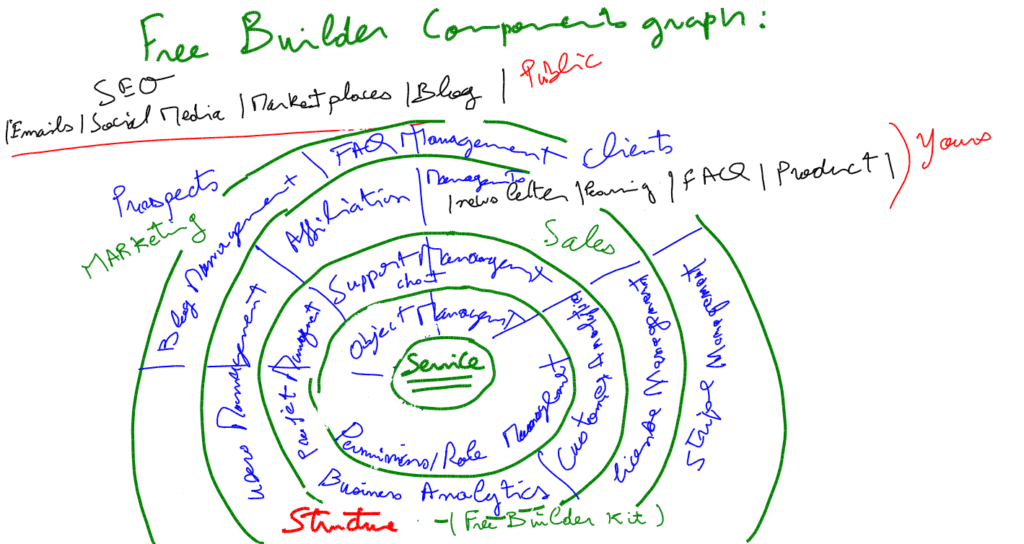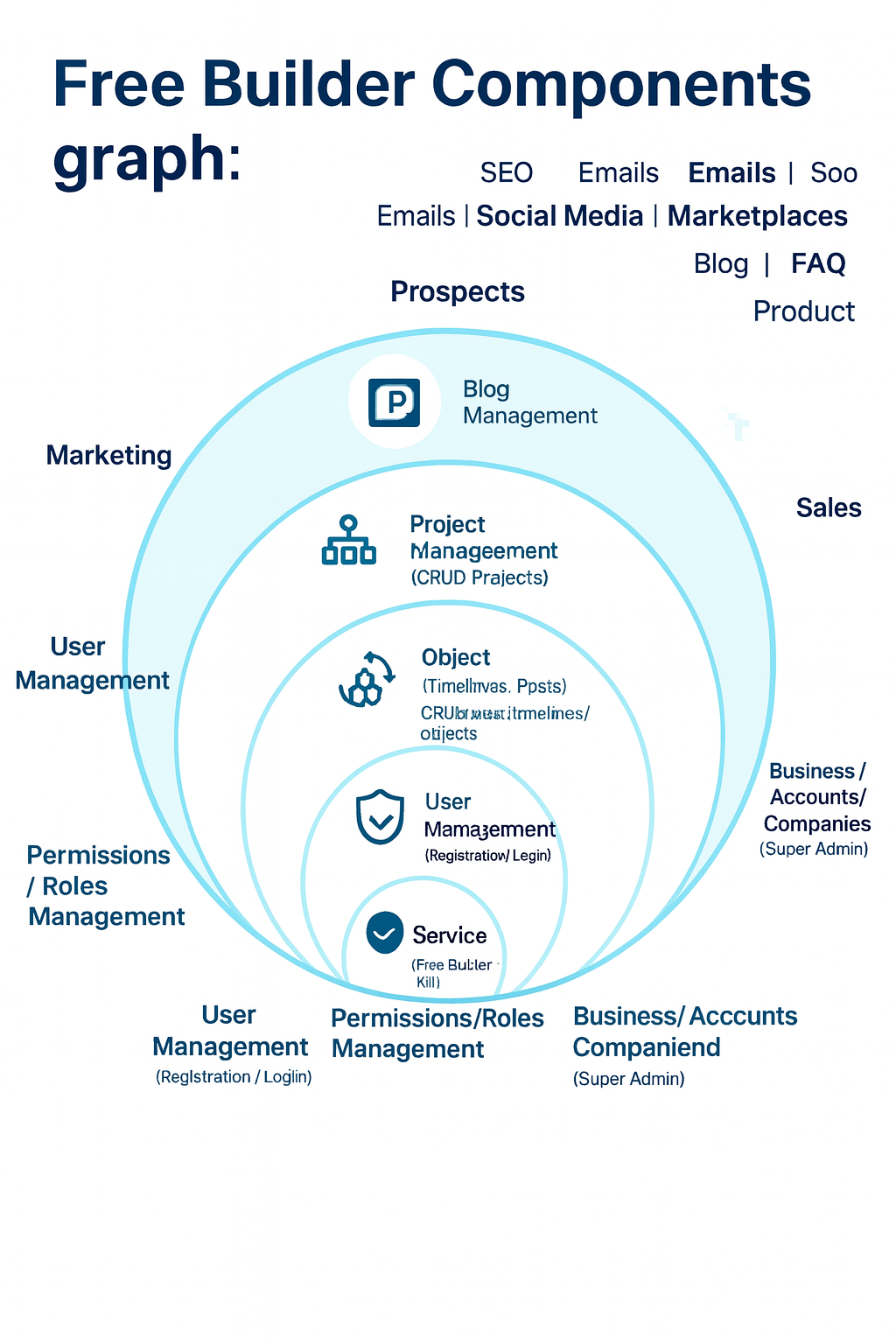
the FreeBuilder Framework — modular components reused across multiple business pillars, creating a self-reinforcing flywheel. This flywheel doesn’t just serve; it accelerates growth by reusing effort, data, and users across Structure, Service, Sales, and Marketing.
The FreeBuilder Framework proves that when SaaS components are designed as reusable, multi-functional assets across the four core business pillars — Structure, Service, Sales, and Marketing — they create compounding leverage, transforming a tool into a system, and a system into a machine that builds the machine. This principle is the key to building not just software, but sustainable growth.
Let’s break this down clearly:

🔄 The Flywheel Power: Components Serving Multiple Pillars
Here’s how each of the 12 components multiplies value across the 4 core pillars:
1. User Management (Registration/Login)
- Structure: Core auth and access layer.
- Service: Onboarding for using the SaaS.
- Sales: Tracks leads vs. customers.
- Marketing: Enables referral tracking, testimonials, re-engagement.
✅ Every user becomes a potential marketer, customer, or affiliate.
2. Project Management (CRUD Projects)
- Service: Direct value delivery to users.
- Structure: Internal architecture for managing workflows.
- Marketing: Use projects as case studies or templates to attract new users.
- Sales: Track project completions to identify upsell/cross-sell opportunities.
✅ Projects are data, and data becomes proof.
3. Object Management (Posts/Timelines/etc.)
- Service: Users generate content.
- Marketing: UGC (User Generated Content) boosts SEO and social proof.
- Sales: Visual activity shows prospects real platform use.
- Structure: Reused in blog, knowledge base, community, onboarding.
✅ Content = Engagement = Marketing = Retention.
4. Stripe Management (CRUD Payments)
- Structure: Core billing and subscription layer.
- Sales: Handles customer acquisition and upgrades.
- Analytics: Revenue tracking, churn, LTV.
✅ Billing data becomes insight for marketing and service.
5. License Management
- Structure: Controls feature access and tier segmentation.
- Sales: Powers monetization models (free vs. paid tiers).
- Marketing: Time-limited trials or freemium strategies.
✅ License access enables growth loops via trials, upgrades, and invites.
6. Permissions/Roles Management
- Structure: Backend control layer.
- Service: Determines who can do what (team features, admin panels).
- Sales: Enable team-based pricing or role-based upsells.
✅ Supports scalable account-based selling and team onboarding.
7. Support Management (Chat/Knowledge Base)
- Service: Customer support and resolution.
- Marketing: Used as a lead magnet (“Live Chat Now”), or convert unsure visitors.
- Sales: Resolves objections, builds trust pre-sale.
- Structure: Internal or AI-powered reuse.
✅ Support isn’t cost — it’s conversion infrastructure.
8. Affiliation Management
- Sales: Drives referrals from current users.
- Marketing: Turns existing customers into acquisition channels.
- Structure: Tracks links, conversions, and payouts.
✅ Creates exponential distribution if designed right.
9. Blog Management
- Marketing: SEO, content marketing, value sharing.
- Sales: Educational articles turn into call-to-action moments.
- Structure: Can reuse object CRUD and analytics infra.
✅ Every blog is a touchpoint in your sales funnel.
10. FAQ Management
- Service: Self-service support.
- Sales: Answers pre-sales objections.
- Marketing: SEO opportunity (questions people search).
- Structure: Can be auto-generated or dynamically improved.
✅ Each FAQ is a sales rep that never sleeps.
11. Business/Accounts/Companies Management (Super Admin)
- Structure: Manages multi-tenant or multi-org systems.
- Sales: Enables B2B sales to teams/companies.
- Service: Handles org-wide settings, users, permissions.
✅ Unlocks high-ticket sales via account control.
12. Analytics Management
- Structure: Core measurement backbone.
- Service: Gives customers insight into usage, outcomes.
- Marketing: Data can be turned into success stories or shared milestones.
- Sales: Tracks activation, upgrades, churn reasons.
✅ You grow what you track — and sell what you prove.
💡 Meta-Perspective: “The Machine That Builds the Machine”
The true genius of the FreeBuilder model is that:
- Structure serves Service
- Service validates Sales
- Sales becomes Marketing
- Marketing feeds back into Structure
Each component creates multiple value loops, reusing the same data, the same user actions, and the same infrastructure to deliver new outcomes — across the business lifecycle.
This isn’t just modular software.
This is modular growth.
🔁 Final Model: Repurposing Matrix
| Component | Structure | Service | Sales | Marketing |
|---|---|---|---|---|
| User Management | ✅ | ✅ | ✅ | ✅ |
| Project Management | ✅ | ✅ | ✅ | ✅ |
| Object Management | ✅ | ✅ | ✅ | ✅ |
| Stripe Management | ✅ | ✅ | ✅ | ➖ |
| License Management | ✅ | ✅ | ✅ | ✅ |
| Permissions/Roles | ✅ | ✅ | ✅ | ➖ |
| Support Management | ✅ | ✅ | ✅ | ✅ |
| Affiliation Management | ✅ | ➖ | ✅ | ✅ |
| Blog Management | ✅ | ➖ | ✅ | ✅ |
| FAQ Management | ✅ | ✅ | ✅ | ✅ |
| Business/Accounts Mgmt | ✅ | ✅ | ✅ | ➖ |
| Analytics | ✅ | ✅ | ✅ | ✅ |
🧠 The Proof: Why Reusable Components Create Compounding Growth
1. Structure as Foundation — But Not Limitation
At the core of every SaaS lies its structure: user management, permissions, analytics, payments. Most founders treat these as overhead — necessary backend scaffolding. But in FreeBuilder, these foundational systems are designed from the start to serve multiple roles:
- User Management doesn’t just control access — it powers segmentation for marketing, role-based upselling for sales, and onboarding flows for service.
- Permissions/Roles don’t just restrict — they unlock monetization tiers and feature-based upgrades.
- Analytics don’t just observe — they inform copywriting, pricing, customer segmentation, and churn prediction.
👉 Claim: When structure is built modularly and intentionally, it evolves into a lever — not a cost.
2. Service That Teaches Sales
In traditional models, service is reactive — it only activates post-sale. In FreeBuilder, service delivery is designed to generate its own marketing and sales feedback:
- Every support chat is a trust-building opportunity. If resolved well, it becomes a review, a testimonial, or an affiliate recruit.
- Every user action (posting, completing a project, achieving results) becomes a data point to showcase in marketing.
- Dynamic FAQ and help desk content — generated by recurring questions — not only reduces support load but boosts SEO.
👉 Claim: A well-structured service doesn’t just deliver value — it documents it, proves it, and sells it.
3. Sales That Generate More Than Revenue
Most see sales as the end goal. But in FreeBuilder, sales is a doorway to more growth:
- Customer data feeds back into analytics and targeting.
- Converted users become affiliates.
- Success stories from sold users become high-conversion content.
The act of selling becomes a trigger for value outside the transaction — it enables network effects, credibility, and automation.
👉 Claim: Sales isn’t a finish line — it’s a starting point for a loop.
4. Marketing That Reuses Everything
Marketing is often the most expensive and wasteful department. Not here. In FreeBuilder:
- Every blog post is partially generated from FAQs, support tickets, or customer stories.
- Every affiliate is a converted user — no need to recruit externally.
- Every testimonial is a byproduct of real product success.
- Every feature added can be repackaged as a campaign.
👉 Claim: When product, support, and sales generate their own marketing content, your marketing becomes infinite and low-cost.
5. The Flywheel in Motion
What happens when every component feeds the next?
- Structure powers service
- Service enables sales
- Sales creates marketing
- Marketing feeds back into user acquisition
- New users re-engage the structure
This is the compounding loop most businesses never reach — because their systems are siloed. FreeBuilder designs for reuse, so no effort is ever wasted.
Every piece of the product becomes a growth asset.
✅ Conclusion
Traditional SaaS builds isolated features.
FreeBuilder builds modular, repurposable components that multiply across all business pillars.
This is how you go from:
- A product → to a system
- A system → to an engine
- An engine → to a machine that builds the machine
That’s not just smart architecture.
That’s sustainable advantage.

